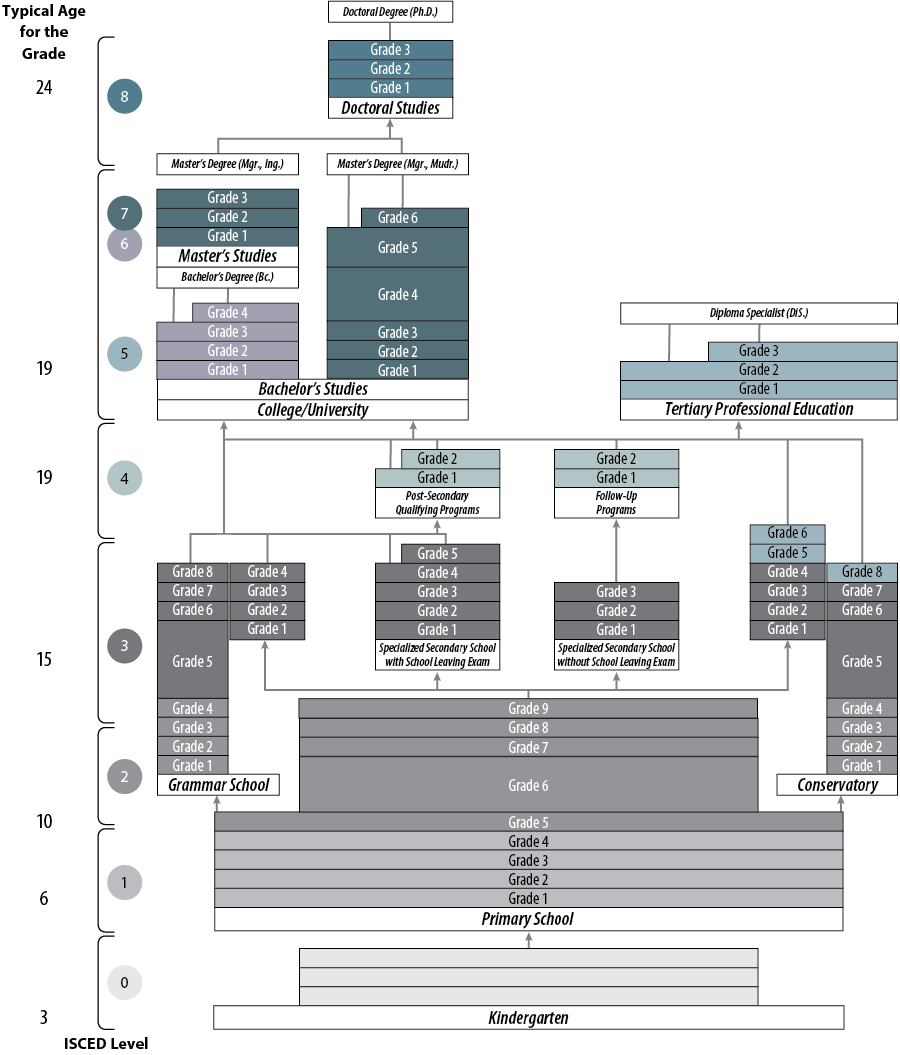Overview of Education System
The education system of the Slovak Republic is partially decentralized. At the national level, the Ministry of Education, Science, Research, and Sport oversees the administration of the public school system; develops educational concepts and a unified educational policy; and creates laws, general regulations, and documents related to education (e.g., curriculum documents). Federal oversight is exercised through the State School Inspection, which conducts independent school inspections to monitor and evaluate achievement in education and training in schools.2 Private or church schools are run by an individual, legal entity, or officially approved church. Private schools receive contributions from parents, as well as state subsidies.
Municipalities are responsible for administration of primary schools, preschools, and school facilities, while self‑governing regions administer secondary and special schools. Each primary and secondary school is managed by a principal who primarily is responsible for curriculum implementation, integration of professional and pedagogical standards into the teaching process, evaluation and ongoing education of the teaching staff, budget management and effective use of school financial resources, and the first level of state administration for individual students (e.g., admission, exclusion, delayed enrollment, permission to follow an individual study plan). The principal cooperates with the school board, which functions as a public monitor and comprises pedagogical and nonpedagogical school employees, parents, students (at secondary schools), and representatives of the municipality or self‑governing region.3
The school year has approximately 180 instructional days, beginning in September of each year. The official teaching period ends on June 30 and is followed by holidays in July and August.
Structure of the Education System
The four main levels of the education system in the Slovak Republic are preprimary, primary, secondary, and higher education. Preprimary education (UNESCO’s ISCED Level 0) is voluntary but is encouraged by a no‑fees policy in the last grade.4 In the 2012–2013 school year, the gross enrollment ratio of students in preprimary education was 87.3 percent. Considered part of the Slovak education system, preprimary education is organized according to official documents that have been approved by the Ministry. It is designed for children ages 3 to 6 and includes general kindergartens (materská škola) and special kindergartens for children with special education needs. In addition to preparing children for primary education, the goal of preprimary education is to help and encourage them to interact socially with peers, develop personalities, and develop a relationship to knowledge and learning through play. An important aspect of preprimary education is close cooperation with children’s families. Children who have attended at least the last grade prior to primary education are considered to have graduated from preprimary school.
Compulsory education in Slovakia begins in primary school (základná škola) and lasts for 10 years (ages 6 to 16). Primary school consists of two stages: the first stage (Grades 1 to 4) provides primary education (ISCED Level 1), and the second stage (Grades 5 to 9) provides lower secondary education (ISCED Level 2). Children from socially disadvantaged backgrounds who have not reached the maturity level necessary for primary school by age 6 have the option of attending an additional year of preprimary school, Grade 0. Students with special education needs can attend special primary schools.
Students take the national Testing 5 examination in Grade 5. Those with special talents in academic subjects or the arts can apply for enrollment in an eight year grammar school or conservatory, both of which usually have their own entrance examinations. In Grade 9, students take the national Testing 9 examination in mathematics and their language of instruction (and Slovak, for students who have studied in a minority language). Students may then apply to a secondary school, which may require them to pass an additional entrance examination.
The three types of secondary schools in the Slovak Republic are grammar schools (gymnázium), specialized secondary schools (stredná odborná škola), and conservatories (konzervatórium). Offering academic courses in a variety of subjects, grammar schools primarily prepare students to study at higher education institutions. Specialized secondary schools prepare students for a range of professions, from manual vocations to professional careers in business and technical fields. Conservatories prepare students for careers in the arts or for higher education study.5 Depending on the type of secondary education students have completed, they may continue their studies via post‑secondary education (ISCED Level 4), higher professional education (ISCED Level 5b), or university education (ISCED Level 5a). Exhibit 1 shows an overview of the educational system of the Slovak Republic with the most common educational pathways. For brevity, the parallel system of special schools has been omitted.
Exhibit 1: Overview of the Educational System in the Slovak Republic

